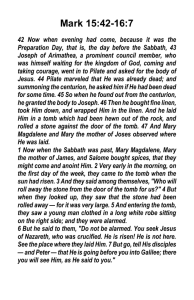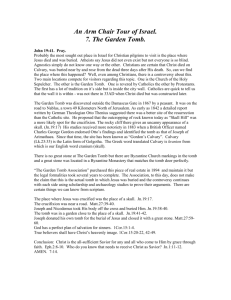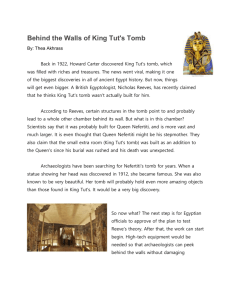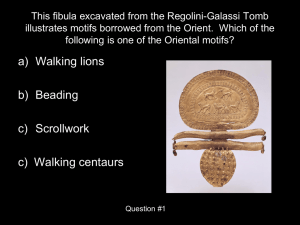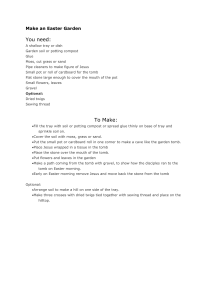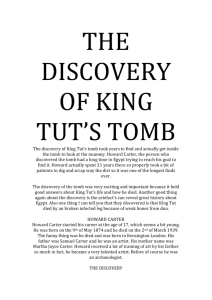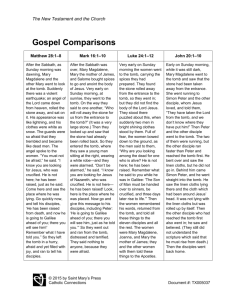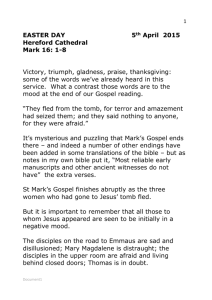To and from the Tomb - Shandon Presbyterian Church
advertisement
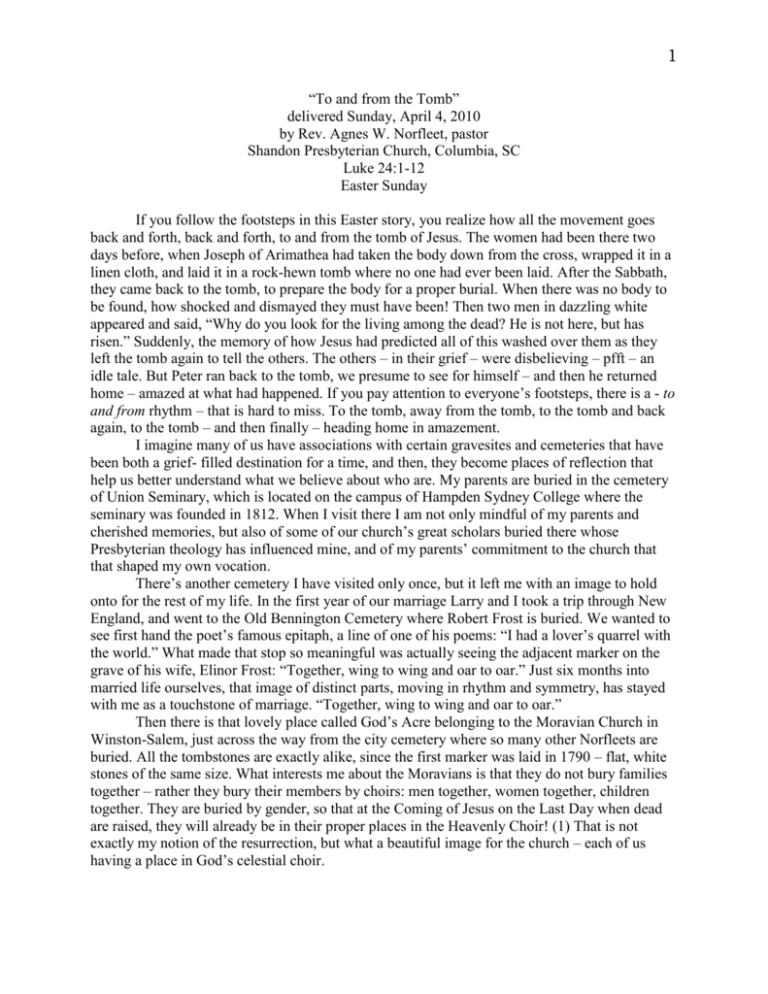
1 “To and from the Tomb” delivered Sunday, April 4, 2010 by Rev. Agnes W. Norfleet, pastor Shandon Presbyterian Church, Columbia, SC Luke 24:1-12 Easter Sunday If you follow the footsteps in this Easter story, you realize how all the movement goes back and forth, back and forth, to and from the tomb of Jesus. The women had been there two days before, when Joseph of Arimathea had taken the body down from the cross, wrapped it in a linen cloth, and laid it in a rock-hewn tomb where no one had ever been laid. After the Sabbath, they came back to the tomb, to prepare the body for a proper burial. When there was no body to be found, how shocked and dismayed they must have been! Then two men in dazzling white appeared and said, “Why do you look for the living among the dead? He is not here, but has risen.” Suddenly, the memory of how Jesus had predicted all of this washed over them as they left the tomb again to tell the others. The others – in their grief – were disbelieving – pfft – an idle tale. But Peter ran back to the tomb, we presume to see for himself – and then he returned home – amazed at what had happened. If you pay attention to everyone’s footsteps, there is a - to and from rhythm – that is hard to miss. To the tomb, away from the tomb, to the tomb and back again, to the tomb – and then finally – heading home in amazement. I imagine many of us have associations with certain gravesites and cemeteries that have been both a grief- filled destination for a time, and then, they become places of reflection that help us better understand what we believe about who are. My parents are buried in the cemetery of Union Seminary, which is located on the campus of Hampden Sydney College where the seminary was founded in 1812. When I visit there I am not only mindful of my parents and cherished memories, but also of some of our church’s great scholars buried there whose Presbyterian theology has influenced mine, and of my parents’ commitment to the church that that shaped my own vocation. There’s another cemetery I have visited only once, but it left me with an image to hold onto for the rest of my life. In the first year of our marriage Larry and I took a trip through New England, and went to the Old Bennington Cemetery where Robert Frost is buried. We wanted to see first hand the poet’s famous epitaph, a line of one of his poems: “I had a lover’s quarrel with the world.” What made that stop so meaningful was actually seeing the adjacent marker on the grave of his wife, Elinor Frost: “Together, wing to wing and oar to oar.” Just six months into married life ourselves, that image of distinct parts, moving in rhythm and symmetry, has stayed with me as a touchstone of marriage. “Together, wing to wing and oar to oar.” Then there is that lovely place called God’s Acre belonging to the Moravian Church in Winston-Salem, just across the way from the city cemetery where so many other Norfleets are buried. All the tombstones are exactly alike, since the first marker was laid in 1790 – flat, white stones of the same size. What interests me about the Moravians is that they do not bury families together – rather they bury their members by choirs: men together, women together, children together. They are buried by gender, so that at the Coming of Jesus on the Last Day when dead are raised, they will already be in their proper places in the Heavenly Choir! (1) That is not exactly my notion of the resurrection, but what a beautiful image for the church – each of us having a place in God’s celestial choir. 2 If you journey – either on foot, or in your memory – to and from cemeteries of significance and meaning in your life, you will find yourself in good company with the first disciples. To the tomb the first time, we can only imagine how they must have left, doubled over in grief for Jesus. Then back again, still grieving but with a job to do, spices in hand. Then from the tomb again, not only with the news: “He is not here, but has risen!” But also with the memory of what Jesus had said when he was still with them, that he would suffer, and be killed, and on the third day he would rise.” From the tomb, they went with words they would hold onto for the rest of their lives; his words that had come true, a touchstone for their faith – and ours. Then Peter, God bless him, had to run back, stoop and look in, see for himself, and then from the tomb again he went home rejoicing. Their footsteps mirror the grief, and acceptance, and assurance of us who have come to believe. Think of the cemeteries we have frequented together – here in Columbia – Elmwood and Greenlawn, all those rural graveyards near the old home church or the family farm, and our own Shandon Memorial Garden. You have your stories – as I have shared mine – of graves where you have gone in sadness to cherish your loved ones, to give thanks for life lessons learned, to remember who you are in relationship to that great cloud of witnesses, and from which to journey home with amazement that the graves which have caught our tears cannot hold the ones for whom we have wept. You have your stories of significant deaths and burial places – just as I have mine – but the real beauty of this Easter story is that there is One Tomb – to which all of us are invited to frequent, and from which all of us find our way home, amazed and believing. About a month ago, the world’s compassionate attention had moved from Haiti to Chile just days after the earthquake there. It had been seven weeks since the Haiti quake, the rainy season was approaching and the displacement of all those Haitian people seemed unabated. In the midst of all the bad news was a story of a cemetery and a homecoming. A six-year-old girl had been found just days after the quake wandering in the streets, and all they knew about her is that her name is Sterling. She was taken to a camp for displaced children. A UNICEF expert on tracing lost families asked little Sterling about her life before the houses fell down. The relief worker gave her a pad of paper, and soon the child was drawing her home, her church with a cross on top, and just in front of her house, a large graveyard. Along with her drawing, they took Sterling back to the street where she was found wandering and lost after the earthquake. Suddenly she was pointing out the car window. The UNICEF worker said, “When she was drawing her home, she drew a cemetery, and I wasn’t sure it was true, but there it is.” They continued on foot, the child a bit confused for all the rubble. Then suddenly she spotted an alleyway; she raced ahead, running – dancing almost – up a narrow slope covered with rubble. “That was my house,” Sterling exclaimed, “it’s broken now.” Then into a tented town where she found an aunt and her sister. They had a cell phone number for her father who said, “I’m coming to see you.” She raced back down the hill, and for the first time in seven weeks, into her father’s outstretched arms. “I walked everywhere looking for you,” he cried, a father and daughter reunited. Little Sterling was home again, amazed and joyful, because the memory of a cemetery had led her there. The gospel account of Jesus’ resurrection does not answer all our questions about the mystery of death, nor does it completely mend our broken hearts. But the testimony of these women, and the amazement of Peter, assure us that we are in the living company of One whom God raised from the dead. The resurrection is God’s great act in human history that has become the center of our individual histories. So we have our cemeteries – to and from which we have found our way in this world, and we all have this one Tomb of Jesus Christ – to and from which 3 – we have found our faith and hope. For the women, for Peter, for all the disciples, and for us, the grave is always – for a time – a destination of great sorrow. And then, as the good news of resurrection washes over us, we realize that its sheer emptiness helps us find the way home, amazed by what God has done! AMEN. NOTES 1) Remembered and verified by salemcongregation.org of the Old Home Moravian Church in Winston-Salem. 2) msnbc.com. Nightly News with Brian Williams archives, March 1, 2010, “Haitian father and daughter reunited.”
